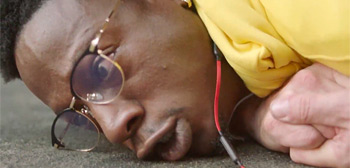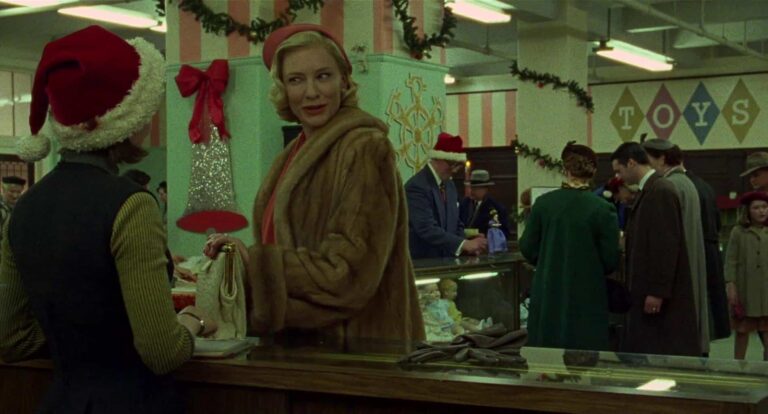How GOLDENEYE Saw Dimly Into The Future Of Bond
Twice in the history of the James Bond film series, director Martin Campbell has found himself charged with the daunting responsibility of toppling 007 over the precipice of modernity into a brave new world. In 2006, he left an indelible stylistic bloodstain on the spy genre when he gave violent birth to the Daniel Craig era with Casino Royale—a stunningly brutal character study that lacerated Bond’s immaculate surface, interrogating the wounded soul of a masculine icon divested of his traditional invulnerability, while also boasting some of the most genuinely nasty action set pieces ever seen in a modern blockbuster. Campbell replaced the franchise’s routine opening stunt sequence with a terse black-and-white showdown reminiscent of classic films noir, and he never looked back. Casino Royale is unquestionably the most radical Bond film ever made, and probably the best.
Campbell‘s first crack at Bond, though, came in 1995, helming GoldenEye—the franchise’s big return after a prolonged hibernation of six years. There’d been a sea change since the release of the previous instalment, Licence to Kill—GoldenEye was the first film in the series not to base its story on Ian Fleming‘s writing, the first to be released post-Cold War, the first to use CGI, and the first to star Pierce Brosnan in the role of 007.
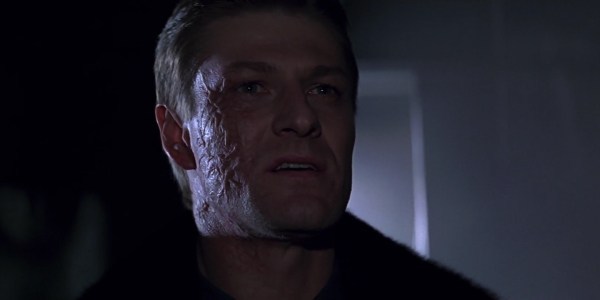
New material, new politics, new effects, new leading man—a different cocktail entirely. When you put it like that, you’d think that GoldenEye should surely be the most distinctive, most revolutionary Bond film of them all, comprehensively transforming the look, sound, and feel of the spy genre. But as the film turns 25, its greatest crime is still just how tentative it is in probing uncharted territory—how often it lapses into the simplistic past, and shies away from the tangled future. All of the elements that make the Craig era so emotionally and intellectually muscular are here in their infancy: the prickliness of Bond’s relationship with Judi Dench‘s matriarchal M; the tormented villain whose pain throws MI6’s conduct into moral dubiety; and Bond’s confrontation with a modern world in which he’s an increasingly endangered species of brute. But while Casino Royale attacks the foundations of the franchise with total abandon, GoldenEye plays it painfully safe, too afraid of total structural collapse.
Still, even if GoldenEye might not be the game-changing masterpiece that it might’ve been, it does play the Bond game well. Endless innuendos, horny women, fast cars, goofy gadgets, cascading explosions—all deftly orchestrated within a sturdy, reliable framework. It’s brilliant entertainment, familiar and cosy, but spiked with the occasional self-aware complication.
Alec the Great
The most memorable of those complications, of course, is Sean Bean‘s Alec Trevelyan, Bond’s disfigured ex-teammate who’s revealed to be the evil mastermind behind a planned electromagnetic pulse attack on Britain. Showing Bond and Trevelyan working together on a mission in perfect harmony at the beginning of the film is a smart and poignant move, establishing a sentimental tether between the hero and the villain whom he’ll inevitably have to thwart and condemn to fiery destruction. That sense of fractured friendship adds a dash of vinegar to the martini, just enough to give you mild heartburn as you drink in the obligatory sweet sensation of watching Bond punch and shoot his way to saving the world again—or in this case, the Bank of England, I guess.
So, yes, the process is more painful than usual—but maybe just not painful enough. Trevelyan’s rage stems from the betrayal of his Cossack parents when he was a child by the same British government that recruited him as an agent, thinking that he’d be too young to remember his irrevocable loss. It’s certainly a compelling idea, besmirching the hagiographical portrait of the British state that usually comes with the franchise. In the film’s most visually striking sequence, Campbell even stages Bond and Trevelyan’s first reunion as enemies amongst the spectral ruins of Soviet monuments, a chiaroscuro encounter in which personal traumas are set against the backdrop of national collapse.
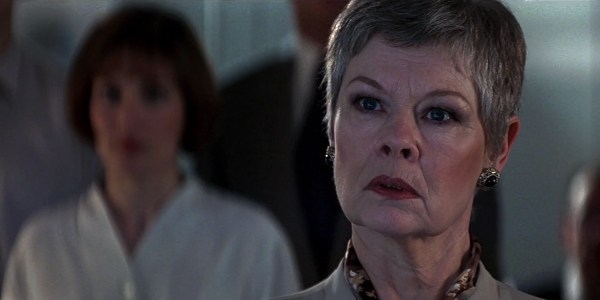
In the end, though, Brosnan‘s Bond never really has to wrestle with his feelings towards the crimes of his own nation—Trevelyan plants a seed of doubt, but it never germinates, as GoldenEye quickly settles back into a more comfortable rhythm of moral simplicity. What should feel thorny instead feels perfunctory, and it wouldn’t be until Casino Royale that the franchise would more thoroughly scrutinise the ugliness of its supposed heroes. You could argue that Javier Bardem‘s Raoul Silva in Skyfall is the Craig era’s closest analogue to Trevelyan, but actually, Craig‘s Bond himself is, in essence, Trevelyan remastered—a man who’s been relentlessly beaten down by the hammer of his own government, burdened with thankless mission after thankless mission, engineered by the ostensible good guys into an unfeeling death machine. How’s that for complicated?
Golden Girls
Indeed, so extreme is the dispassion of MI6 in the Craig era that Judi Dench‘s M eventually becomes a sort of secondary villain, reaping the bitter crop of her cyanide-laced cruelty. GoldenEye only superficially prefigures that particular emotional thread when M bluntly informs Bond of her willingness to send him to his death, but it more tangibly anticipates the tension between desk and field that mounts unabated as the franchise progresses further and further into technological modernity. Dubbed by her disapproving male underlings as the “evil queen of numbers,” Dench‘s M carries with her a reputation as an “accountant,” more concerned with business than action, unequipped and unqualified to make cogent leadership decisions. It’s a pretty straight line from here to the somewhat conceited and undercooked debates about computers versus boots on the ground in Spectre, a cri de cœur for Bond’s continuing relevance in the 21st century.
There’s also, of course, more than just a whiff of misogyny in the air, that distinctive miasma that clings to men’s tuxedos, whose pungency can’t be covered up with just one wash. It’s there in Bond’s sceptical gaze as much as it’s in his subtle barbs, and it’s there in M’s own pre-emptive attack on Bond’s sexist disposition. Would a man be forced to justify himself so early, with such venom? Were the credentials of any previous, male leaders ever put under the same microscope?
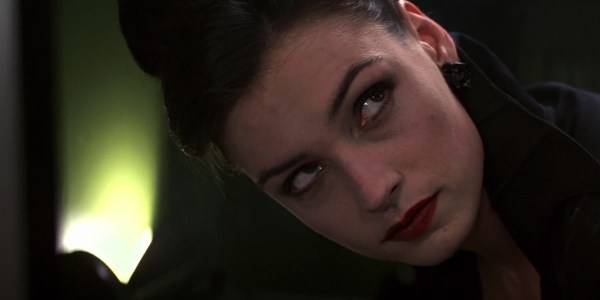
Taking over the role from Robert Brown, who played M in the previous four films in the series, Dench is just as ruthlessly efficient in GoldenEye as she was when she won the Academy Award for Best Supporting Actress with just eight minutes of screen time in Shakespeare in Love. The severe features, the steady voice, the stinging words—her iteration of MI6’s top dog is happy to play the bitch if it means that her pups recognise their damned place. Even with just a handful of scenes, Dench‘s inimitable presence, that authentically British brand of icy authority, demands that the actors around her sharpen their games.
Efficiency might also be the greatest virtue of Izabella Scorupco, whose unfussy work as computer programmer Bond girl Natalya Simonova is probably a bit underrated these days. Natalya is competent, combative, bracingly irreverent—and, I don’t know, maybe if she’d had some sort of phallic or vaginal pun somewhere in that moniker of hers, her legacy as one of the more decently developed heroines in the series might’ve been clinched.
Then again, side by side with Famke Janssen‘s Xenia Onatopp, a one-woman army of sex and destruction, she never really had a chance of being remembered. Campbell might’ve refined the cinematic duel/seduction to elegant, sizzling perfection with the iconic swordfight between Antonio Banderas and Catherine Zeta-Jones in The Mask of Zorro—but nothing can quite match the more chaotic frisson of Bond’s libidinal exchanges of fluids and violence with Onatopp. All crazed eyes, gnashing teeth, and heavy breathing, Janssen‘s man-eating assassin with an insatiable appetite is the gold standard for Bond henchmen, and probably for henchmen in general—after all, there isn’t an action film in existence that wouldn’t benefit from an uncontrollably horny villainess with thighs like hydraulic presses.
Era-Piercing
If time, or rather timing, has been especially cruel to anything in GoldenEye, it’s Pierce Brosnan, that once-loved but now much-maligned figure in Bond history, who himself admits that he hates watching his own performances as 007. Recent re-evaluations of Brosnan‘s tenure have produced charges of smugness, humourlessness, and even laziness. His 007 has been diagnosed with a crippling identity crisis, suspended in limbo somewhere between Sean Connery and Roger Moore, bereft of the magic of either.
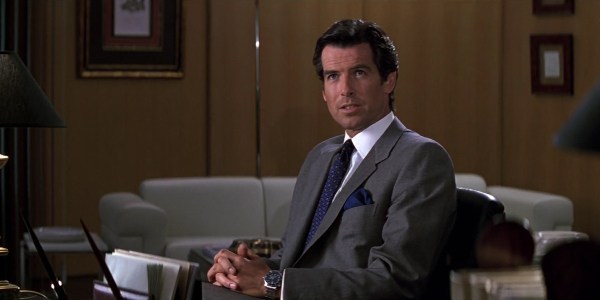
There’s certainly a degree of accuracy to that diagnosis, but I wonder if the treatment should be administered to the Brosnan-era screenwriters rather than to Brosnan himself. Throughout GoldenEye, you can already feel the cogs of the old Bond machinery chafing against the new components of the screenplay by Jeffrey Caine and Bruce Feirstein, generating unproductive friction no matter how much lubricant Brosnan might bring. Yes, lip service is paid to a sense of innocence lost, but it’s imprecise, slipshod, and occasionally cringeworthy. If Brosnan comes across as self-satisfied, it’s only because the material that he’s given is far too happy to poke fun at the mechanics of the franchise without ever really innovating at all.
More than anything, Brosnan is a casualty not of the heights reached by his predecessors, but of proximity to his successor. Daniel Craig, with his thoughtful and bruising 007, will be a hard act to follow, and he’s already proven to be a hard act to precede—such a sudden, extreme departure from the conventions of the character, such a total reinvention, inevitably eclipses the qualities of the version in closest orbit. And make no mistake, Brosnan‘s qualities are numerous—physicality, acerbity, and sensitivity, all compactly bundled into a package of cucumber-cool charisma. It’s a shame that so many think that his achievements have to be diminished because of Craig‘s enormity.
Somebody Does It Better
All of this is to say that, basically, GoldenEye is good—very good, even, particularly as an action spectacle. What it’ll always offer in abundance are the pulsating, primordial pleasures of the genre—the ridiculous ravine dive and aeroplane escape, the tank chase through the streets of Saint Petersburg (which boasts a gloriously brazen amount of collateral damage), and the gruelling hand-to-hand combat atop of a giant satellite dish. Savour the tactility and heft of these images, with their lovingly crafted miniatures, chunky practical effects, ambitiously choreographed stunt work, and Campbell‘s energetic direction—you won’t find many modern blockbusters that look this handsome.
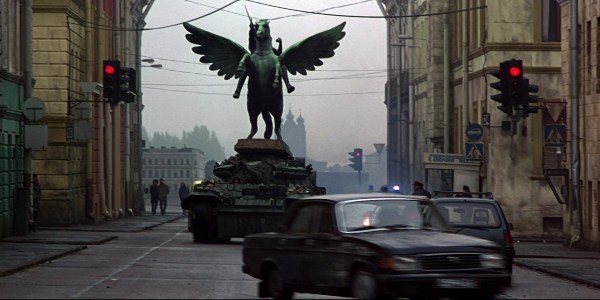
And none of this is to say that every action film has to directly address or somehow subvert its more problematic facets in order to be entirely successful. Where’d be the fun in that? There’s nothing egregious about simply being solid or satisfactory, without plumbing every possible depth for a new quandary over which to ruminate.
Conclusion
But, like any instalment in a film franchise, GoldenEye inherently courts comparisons to its progenitors and its progeny alike. In that light, the gloss on the surface begins to flake away, and the defects beneath are exacerbated—everywhere you look, there’s wasted potential. It’s fitting, I suppose, that Trevelyan’s master plan involves using what’s essentially a space laser to commit a glorified act of petty theft. GoldenEye has enough firepower to torch Planet Bond twice over but ultimately settles for making a medium-sized crater.
What are your thoughts on GoldenEye? Let us know in the comments below!
GoldenEye is currently streaming on Netflix in the U.S.
Watch GoldenEye
Does content like this matter to you?
Become a Member and support film journalism. Unlock access to all of Film Inquiry`s great articles. Join a community of like-minded readers who are passionate about cinema – get access to our private members Network, give back to independent filmmakers, and more.
Join now!

